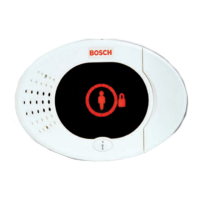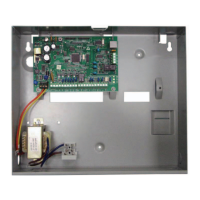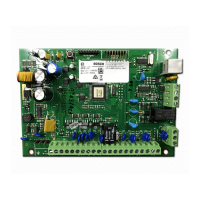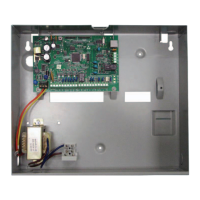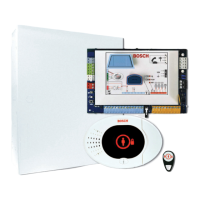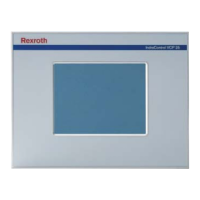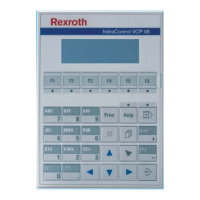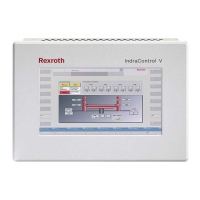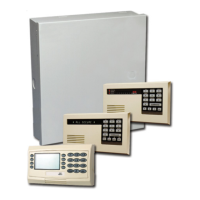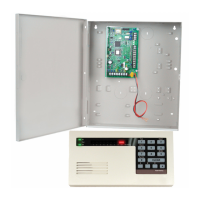Do you have a question about the Bosch ICP-SOL3-P and is the answer not in the manual?
Introduces the TEXT LCD and ICON LCD codepad models.
Provides quick instructions for operating the codepads.
Explains the meaning of various codepad indicator icons and their status.
Describes the different sounds the codepad buzzer makes.
Explains the structure and navigation of the Text LCD codepad menu.
Lists commands available in the Command Menu for the Text LCD codepad.
Details the Access Menu options for user and installer codes.
Lists timer and codepad settings within the System Menu.
Explains how to configure and manage zones in the system.
Describes options for managing different areas or partitions within the system.
Details the configuration of system outputs like sirens or lights.
Covers settings for receiver, network, and report configurations.
Lists options for programming parameters and adapters.
Explains the different modes and methods for arming the security system.
Describes the process and conditions for forced arming the system.
Details the procedures for arming the system in AWAY Mode.
Explains how to arm the system in STAY Mode 1.
Details the procedure for arming the system in STAY Mode 2.
Describes how to program zones for automatic isolation in STAY Mode 2.
Explains the procedure for disarming the security system.
Covers managing user codes for system access and operation.
Details the process of adding new user or radio codes to the system.
Explains how to remove existing user or radio codes from the system.
Introduces various alarm types that can be triggered from the codepad.
Describes the silent hold-up alarm activated by a duress code.
Explains how to activate a panic alarm using the codepad buttons.
Details how to trigger a fire alarm using the codepad buttons.
Describes the procedure to activate a medical alarm from the codepad.
Explains the system's response to multiple invalid user code attempts.
Covers the process of manually disabling zones before arming the system.
Details how any operator can isolate zones without a specific code.
Explains isolation using a specific user code priority level.
Describes how to enter and use Fault Analysis Mode to diagnose system faults.
Provides detailed descriptions of various system faults and their causes.
Explains how to program the system's date and time settings.
Details how to manually turn system outputs on or off via the codepad.
Explains how to reset outputs that are programmed to latch.
Introduces programming for Telco sequences related to call forwarding.
Describes how to program the Telco Arm Sequence for call forwarding.
Explains how to program the Telco Disarm Sequence to disable call forwarding.
Covers various tests to confirm system operation and functionality.
Describes how to perform a test of the system's horn speaker.
Details how to conduct a test of the system's bell output.
Explains how to test the system's strobe light functionality.
Describes how to use Walk Test Mode to check detection devices.
Explains how to send a Test Report for system reporting modules.
Covers how to replay recorded system events and alarms.
Explains how to turn the Day Alarm feature on and off.
Describes how to select different buzzer tones for the codepad.
Explains how to arm the system remotely using a telephone.
Covers using domestic dialing for alarm notifications.
Describes how to acknowledge incoming domestic alarm calls.
Details how to program telephone numbers for domestic dialing.
Explains how to cancel or disable the domestic dialing feature.
Introduces the TEXT LCD and ICON LCD codepad models.
Provides quick instructions for operating the codepads.
Explains the meaning of various codepad indicator icons and their status.
Describes the different sounds the codepad buzzer makes.
Explains the structure and navigation of the Text LCD codepad menu.
Lists commands available in the Command Menu for the Text LCD codepad.
Details the Access Menu options for user and installer codes.
Lists timer and codepad settings within the System Menu.
Explains how to configure and manage zones in the system.
Describes options for managing different areas or partitions within the system.
Details the configuration of system outputs like sirens or lights.
Covers settings for receiver, network, and report configurations.
Lists options for programming parameters and adapters.
Explains the different modes and methods for arming the security system.
Describes the process and conditions for forced arming the system.
Details the procedures for arming the system in AWAY Mode.
Explains how to arm the system in STAY Mode 1.
Details the procedure for arming the system in STAY Mode 2.
Describes how to program zones for automatic isolation in STAY Mode 2.
Explains the procedure for disarming the security system.
Covers managing user codes for system access and operation.
Details the process of adding new user or radio codes to the system.
Explains how to remove existing user or radio codes from the system.
Introduces various alarm types that can be triggered from the codepad.
Describes the silent hold-up alarm activated by a duress code.
Explains how to activate a panic alarm using the codepad buttons.
Details how to trigger a fire alarm using the codepad buttons.
Describes the procedure to activate a medical alarm from the codepad.
Explains the system's response to multiple invalid user code attempts.
Covers the process of manually disabling zones before arming the system.
Details how any operator can isolate zones without a specific code.
Explains isolation using a specific user code priority level.
Describes how to enter and use Fault Analysis Mode to diagnose system faults.
Provides detailed descriptions of various system faults and their causes.
Explains how to program the system's date and time settings.
Details how to manually turn system outputs on or off via the codepad.
Explains how to reset outputs that are programmed to latch.
Introduces programming for Telco sequences related to call forwarding.
Describes how to program the Telco Arm Sequence for call forwarding.
Explains how to program the Telco Disarm Sequence to disable call forwarding.
Covers various tests to confirm system operation and functionality.
Describes how to perform a test of the system's horn speaker.
Details how to conduct a test of the system's bell output.
Explains how to test the system's strobe light functionality.
Describes how to use Walk Test Mode to check detection devices.
Explains how to send a Test Report for system reporting modules.
Covers how to replay recorded system events and alarms.
Explains how to turn the Day Alarm feature on and off.
Describes how to select different buzzer tones for the codepad.
Explains how to arm the system remotely using a telephone.
Covers using domestic dialing for alarm notifications.
Describes how to acknowledge incoming domestic alarm calls.
Details how to program telephone numbers for domestic dialing.
Explains how to cancel or disable the domestic dialing feature.
| No. of On-Board Zones | 8 |
|---|---|
| No. of Keypads | Up to 4 |
| No. of Partitions | 2 |
| Input Voltage | 16.5 VAC |
| IP Rating | IP30 |
| Communication Interface | RS-485 |

